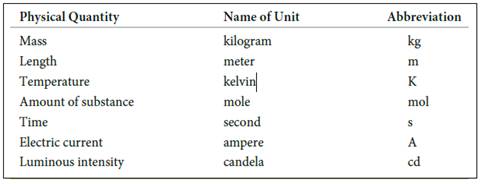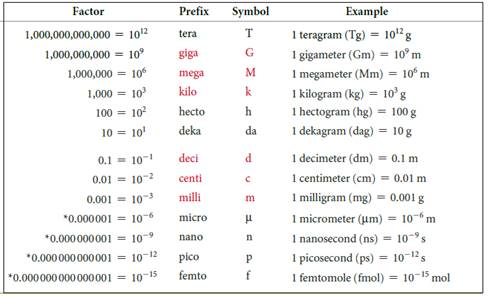
General Chemistry: Atoms First
2nd Edition
ISBN: 9780321809261
Author: John E. McMurry, Robert C. Fay
Publisher: Prentice Hall
expand_more
expand_more
format_list_bulleted
Concept explainers
Question
Chapter 0, Problem 0.32SP
Interpretation Introduction
Interpretation:
The abbreviation of
Concept Introduction:
The seven basic units of measurement includes,

Figure 1
The symbols and their prefix of SI units are discussed below,

Figure 2
Expert Solution & Answer
Want to see the full answer?
Check out a sample textbook solution
Students have asked these similar questions
Find chemical structures based on the below information.
a) Chemical formula C6H8O
Compound is aromatic plus has two 1H NMR peaks that integrated for 3 each that are singlets (it could have
more peaks in the 1H NMR
b) Chemical Formula: C6H100
Compounds is conjugated
'H NMR has a signal that integrates for 6 and is a doublet
IR spectra has a signal at 1730 cm-1
Jaslev
Propose a synthesis of the following starting from benzene and any other reagents and
chemicals. No mechanisms are required. Indicate the condition for each step plus the major product for each
step. More than two steps are required.
Step 1
Step 2
مہد
Br
Part C: The line formula for another branched alkane is shown below.
i. In the IUPAC system what is the root or base name of this compound?
ii. How many alkyl substituents are attached to the longest chain?
iii. Give the IUPAC name for this compound.
Chapter 0 Solutions
General Chemistry: Atoms First
Ch. 0.2 - Express the following quantities in scientific...Ch. 0.2 - What units do the following abbreviations...Ch. 0.5 - The normal body temperature of a healthy adult...Ch. 0.5 - Carry out the indicated temperature conversions....Ch. 0.7 - Prob. 0.5PCh. 0.7 - Chloroform, a substance once used as an...Ch. 0.8 - Prob. 0.7PCh. 0.9 - A 1.000 mL sample of acetone, a common solvent...Ch. 0.9 - Prob. 0.9PCh. 0.9 - Characterize each of the following dartboards...
Ch. 0.10 - Prob. 0.11PCh. 0.10 - Carry out the following calculations, expressing...Ch. 0.10 - What is the temperature reading on the following...Ch. 0.11 - Calculate answers to the following problems, and...Ch. 0.11 - Gemstones are weighed in carats, with 1 carat =...Ch. 0.11 - A pure diamond with a mass of 0.1000 g contains...Ch. 0.11 - Oxalic acid, found in dark-green leafy vegetables...Ch. 0 - Which block in each of the following drawings of a...Ch. 0 - How many milliliters of water does the graduated...Ch. 0 - Assume that you have two graduated cylinders, one...Ch. 0 - The following cylinder contains three liquids that...Ch. 0 - What is the difference between mass and weight?Ch. 0 - What is the difference between a derived SI unit...Ch. 0 - What SI units are used for measuring the following...Ch. 0 - What SI prefix corresponds to each of the...Ch. 0 - Prob. 0.26SPCh. 0 - Prob. 0.27SPCh. 0 - Prob. 0.28SPCh. 0 - Prob. 0.29SPCh. 0 - Prob. 0.30SPCh. 0 - Prob. 0.31SPCh. 0 - Prob. 0.32SPCh. 0 - Prob. 0.33SPCh. 0 - Prob. 0.34SPCh. 0 - Prob. 0.35SPCh. 0 - Prob. 0.36SPCh. 0 - Prob. 0.37SPCh. 0 - Prob. 0.38SPCh. 0 - Prob. 0.39SPCh. 0 - How many significant figures are in each of the...Ch. 0 - Prob. 0.41SPCh. 0 - The Vehicle Assembly Building at the John F....Ch. 0 - Prob. 0.43SPCh. 0 - Prob. 0.44SPCh. 0 - Prob. 0.45SPCh. 0 - Prob. 0.46SPCh. 0 - Prob. 0.47SPCh. 0 - Express the results of the following calculations...Ch. 0 - Prob. 0.49SPCh. 0 - Prob. 0.50SPCh. 0 - Prob. 0.51SPCh. 0 - The normal body temperature of a goat is 39.9C,...Ch. 0 - Prob. 0.53SPCh. 0 - Prob. 0.54SPCh. 0 - Prob. 0.55SPCh. 0 - Prob. 0.56SPCh. 0 - Answer parts (a)(d) of Problem 0.56 assuming that...Ch. 0 - The density of silver is 10.5 g/cm3. What is the...Ch. 0 - Prob. 0.59SPCh. 0 - Prob. 0.60SPCh. 0 - Gaseous hydrogen has a density of 0.0899 g/L at...Ch. 0 - Prob. 0.62SPCh. 0 - Prob. 0.63SPCh. 0 - Prob. 0.64SPCh. 0 - Prob. 0.65SPCh. 0 - Prob. 0.66SPCh. 0 - Prob. 0.67SPCh. 0 - Prob. 0.68SPCh. 0 - Prob. 0.69SPCh. 0 - Prob. 0.70SPCh. 0 - Prob. 0.71SPCh. 0 - Prob. 0.72SPCh. 0 - Prob. 0.73SPCh. 0 - Prob. 0.74CHPCh. 0 - Prob. 0.75CHPCh. 0 - Sodium chloride has a melting point of 1074 K and...Ch. 0 - Prob. 0.77CHPCh. 0 - Prob. 0.78CHPCh. 0 - Prob. 0.79CHPCh. 0 - Prob. 0.80CHPCh. 0 - Prob. 0.81CHPCh. 0 - Prob. 0.82CHPCh. 0 - Vinaigrette salad dressing consists mainly of...Ch. 0 - At a certain point, the Celsius and Fahrenheit...Ch. 0 - Prob. 0.85CHPCh. 0 - Prob. 0.86CHPCh. 0 - An Eastern diamondback rattlesnake was milked...Ch. 0 - Prob. 0.88CHPCh. 0 - Prob. 0.89CHPCh. 0 - Prob. 0.90CHPCh. 0 - Ocean currents are measured in sverdrups (Sv)...Ch. 0 - Prob. 0.92CHPCh. 0 - Prob. 0.93CHP
Knowledge Booster
Learn more about
Need a deep-dive on the concept behind this application? Look no further. Learn more about this topic, chemistry and related others by exploring similar questions and additional content below.Similar questions
- Part D: Draw the Structural Formula for 4-ethyl-2-methylhexane Part E. Draw the Structural Formula for 1-chloro-3,3-diethylpentane (Chloro = Cl)arrow_forwardPart B: The line formula for a branched alkane is shown below. a. What is the molecular formula of this compound? Number of C. Number of H b. How many carbon atoms are in the longest chain? c. How many alkyl substituents are attached to this chain?arrow_forward24. What is the major product for the following reaction? Mg J. H.C CH H,C- Then H₂O OH Br C HO E HO H.C CH H.C- CH₂ CH₂ All of these are possiblearrow_forward
- structures. Explain why the major product(s) are formed over the minor product(s) using the Draw the major and product and the complete mechanism for all products with all resonance mechanism/resonance structures of the major and minor products in your explanation. HONO2 H2SO4arrow_forward#1 (a). Provide the expected product for the following reaction of A to B by indicating what the product is after step 1 (call this "81") and after step 2 (call this product "B2"). Give a complete mechanism for the transformation of compound A into compound B showing all intermediates, resonance structures, stereochemistry and electron movements 1. Et-MgBr 2. Me-Br B #1 (b). Compound A can be prepared in one step from an alkene starting material. Provide the structure a and the reaction conditions required to convert it to compound A The starting alkenearrow_forwardThe line formula for a branched alkene is shown below. 2 i. What is the molecular formula of this compound? Count number of C and H ii. How many carbon atoms are in the longest chain, ignoring the double bond? iii. What is the longest chain incorporating both carbons of the double bond? iv. How many substituents are on this chain? v. Give the IUPAC name for this compoundarrow_forward
- give the products for each of the followingarrow_forwardProvide the products and/or reagents for the following transformations. NaOMe HCl/EtOH OH NaOMe CI Show the product for the formation of the ketal given below for the transformation, showing all intermediates and resonance structures would be required to transform the ketal back to the starting ketone and then the mechanism What reagents/conditions HCI EtOH (excess)arrow_forwardMake meta-dibromobenze from nitrobenzene using amine reactions. *see imagearrow_forward
- Provide the structure of the expected major and minor (if any) products for each reaction. Clearly indicate stereochemistry where warranted. + + heat heat 이요 HNO3 1. AlCl3 2. H₂O H2SO4 1. AlCl3arrow_forward) Give the mechanism for the acid catalyzed hydrolysis of the following to the corresponding carboxylic acid. Show all intermediates and resonance structures N H+, H2O (excess)arrow_forward# 2. Drow full structures of the organic product expected in each of the following reactions. Draw the appropriate stereoisomer where warranted! Tos Cl O C NaCN PCC శ్రీ CI TSCI Pyridine H₂CrO4 PBrj Pyridine NaCNarrow_forward
arrow_back_ios
SEE MORE QUESTIONS
arrow_forward_ios
Recommended textbooks for you
 Chemistry & Chemical ReactivityChemistryISBN:9781337399074Author:John C. Kotz, Paul M. Treichel, John Townsend, David TreichelPublisher:Cengage Learning
Chemistry & Chemical ReactivityChemistryISBN:9781337399074Author:John C. Kotz, Paul M. Treichel, John Townsend, David TreichelPublisher:Cengage Learning
 Introductory Chemistry: An Active Learning Approa...ChemistryISBN:9781305079250Author:Mark S. Cracolice, Ed PetersPublisher:Cengage Learning
Introductory Chemistry: An Active Learning Approa...ChemistryISBN:9781305079250Author:Mark S. Cracolice, Ed PetersPublisher:Cengage Learning Chemistry: The Molecular ScienceChemistryISBN:9781285199047Author:John W. Moore, Conrad L. StanitskiPublisher:Cengage Learning
Chemistry: The Molecular ScienceChemistryISBN:9781285199047Author:John W. Moore, Conrad L. StanitskiPublisher:Cengage Learning Chemistry for Engineering StudentsChemistryISBN:9781337398909Author:Lawrence S. Brown, Tom HolmePublisher:Cengage LearningChemistry: Matter and ChangeChemistryISBN:9780078746376Author:Dinah Zike, Laurel Dingrando, Nicholas Hainen, Cheryl WistromPublisher:Glencoe/McGraw-Hill School Pub Co
Chemistry for Engineering StudentsChemistryISBN:9781337398909Author:Lawrence S. Brown, Tom HolmePublisher:Cengage LearningChemistry: Matter and ChangeChemistryISBN:9780078746376Author:Dinah Zike, Laurel Dingrando, Nicholas Hainen, Cheryl WistromPublisher:Glencoe/McGraw-Hill School Pub Co

Chemistry & Chemical Reactivity
Chemistry
ISBN:9781337399074
Author:John C. Kotz, Paul M. Treichel, John Townsend, David Treichel
Publisher:Cengage Learning


Introductory Chemistry: An Active Learning Approa...
Chemistry
ISBN:9781305079250
Author:Mark S. Cracolice, Ed Peters
Publisher:Cengage Learning

Chemistry: The Molecular Science
Chemistry
ISBN:9781285199047
Author:John W. Moore, Conrad L. Stanitski
Publisher:Cengage Learning

Chemistry for Engineering Students
Chemistry
ISBN:9781337398909
Author:Lawrence S. Brown, Tom Holme
Publisher:Cengage Learning

Chemistry: Matter and Change
Chemistry
ISBN:9780078746376
Author:Dinah Zike, Laurel Dingrando, Nicholas Hainen, Cheryl Wistrom
Publisher:Glencoe/McGraw-Hill School Pub Co
Measurement and Significant Figures; Author: Professor Dave Explains;https://www.youtube.com/watch?v=Gn97hpEkTiM;License: Standard YouTube License, CC-BY
Trigonometry: Radians & Degrees (Section 3.2); Author: Math TV with Professor V;https://www.youtube.com/watch?v=U5a9e1J_V1Y;License: Standard YouTube License, CC-BY